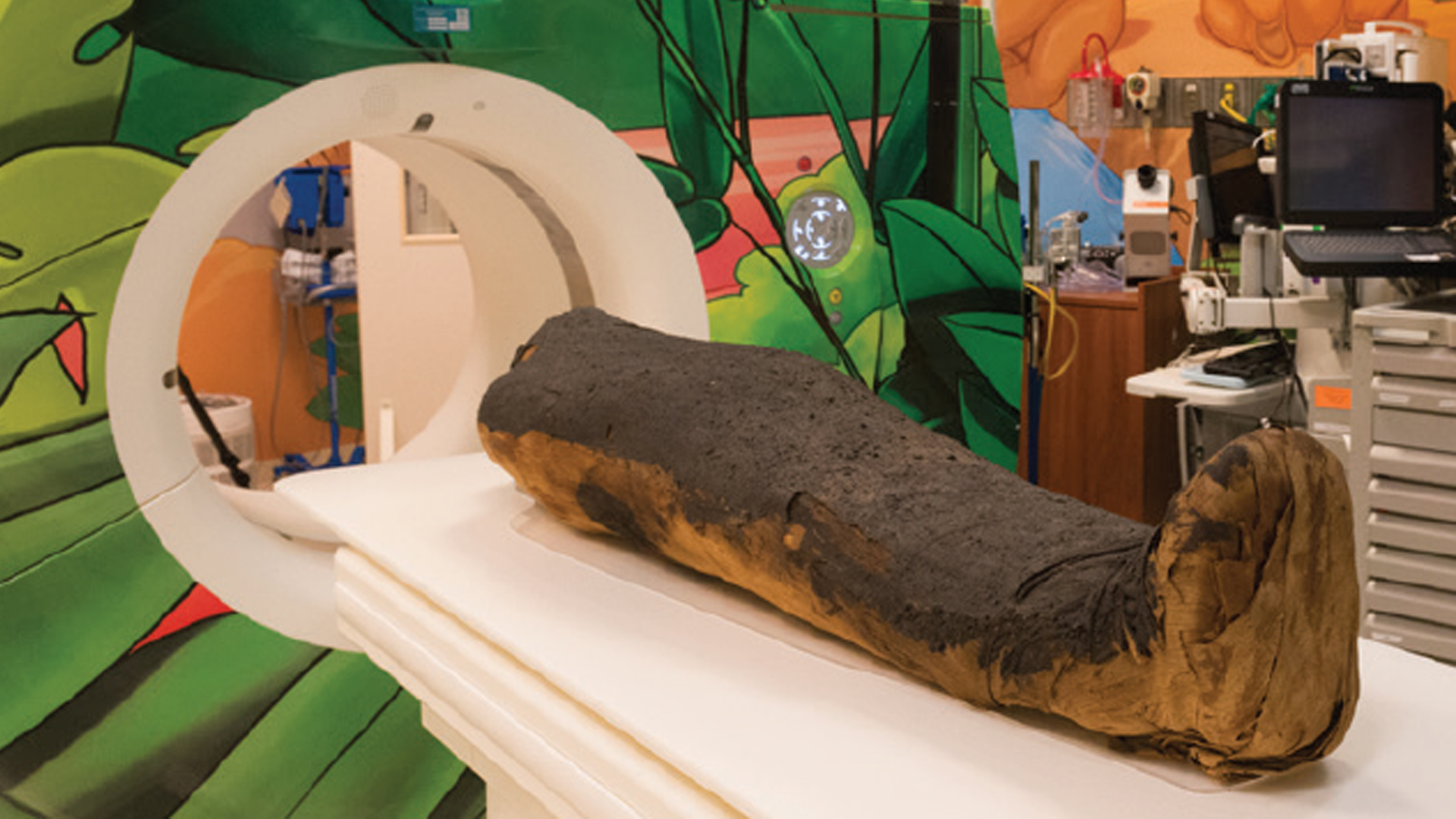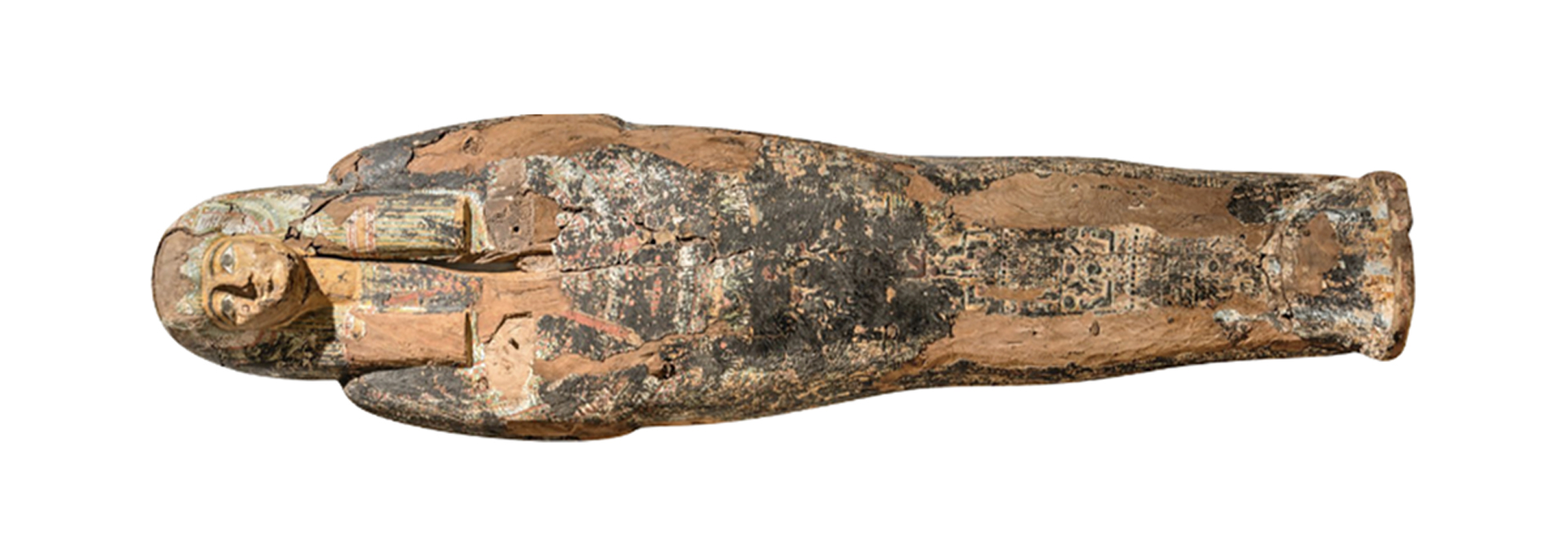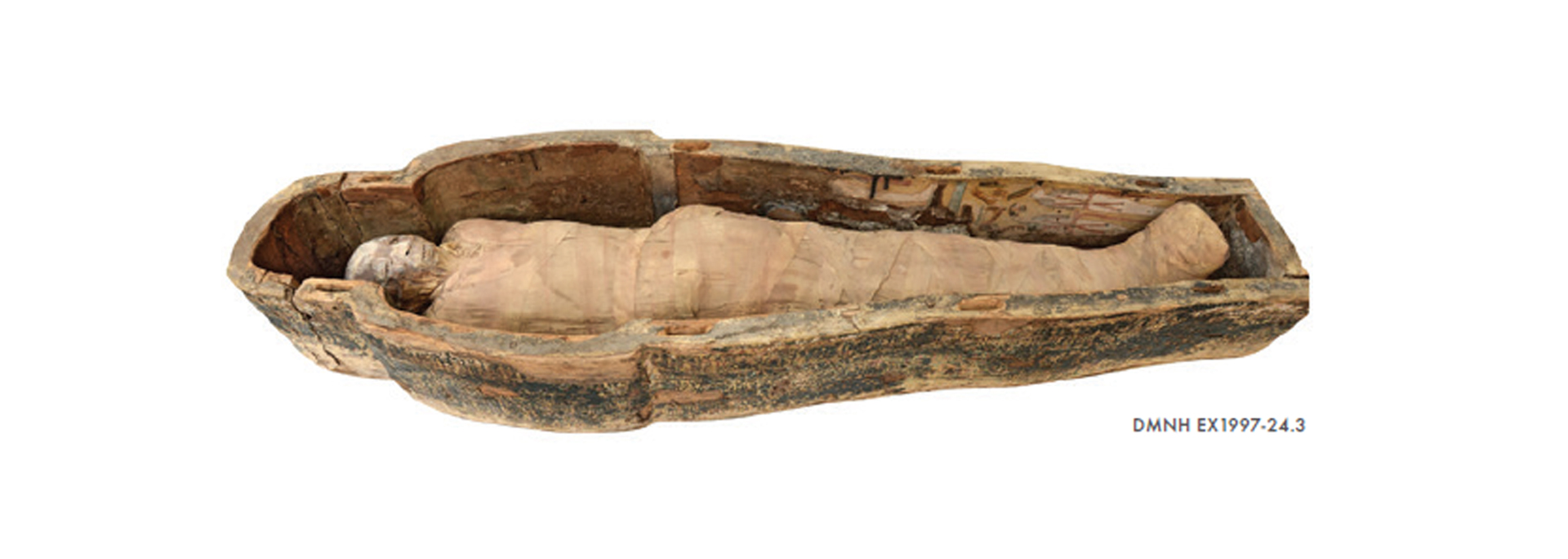Egyptian Mummy Medical Scans
By Michele Koons, Ph.D.
In 2016, a team of scientists undertook new studies on two Egyptian mummies and coffins at the Denver Museum of Nature & Science. New tests included updated CT scans of the mummies, CT scans of one of the coffins, radiocarbon dating, pigment analysis of the paints on the coffins, analysis of the coffin wood, analysis of the style and decoration of the coffins, gas chromatography of the resins, linen analysis, isotope analysis of an eyelash of one mummy, and updated conservation efforts.
In the early 1900s, it was trendy for wealthy tourists to purchase mummies to bring back home. The mummies and coffins came to Colorado in 1905, when Andrew McClelland, an entrepreneur from Pueblo, visited Egypt. The mummies eventually made their way to the Rosemount Museum collection in Pueblo and later to your Museum, where they are now on permanent loan.

The mummies were given many different names after they arrived in Colorado. So many that there is a lot of confusion in the archives. Because of this, we use their catalog numbers here. Mummy EX1997-24.1 has a black coating on the surface and EC1997-24.3 is the mummy with the exposed face.
The mummies were the subjects of a variety of past research projects, including CT scans in the 1990s. The early CT scans indicated that both mummies were females and died between the ages of 30 and 40. The scans also showed that EX1997-24.1 had various amulets and lots of packing to make her more lifelike. The wrappings of EX1997-24.3 are thinner, and there were no immediately identifiable amulets. The scans led researchers to conclude that EX1997-24.1 was rich and EX1997-24.3 was poor. When the Egyptian Hall opened in 2000, the entire exhibit focused on the juxtaposition of “Rich Mummy” and “Poor Mummy.”
To take advantage of dramatically improved CT technology since the mummies were last scanned, we rescanned the two mummies and one coffin using the latest advances at Children’s Hospital Colorado.
This study enabled us to uncover new information, preserve digital data in a medical-grade digital archive, and create three-dimensional reconstructions where we can virtually unwrap the mummies layer by layer. The CT scan of the coffin allowed for us to understand the construction techniques that are not visible from the surface. From this we learned that the quality of construction of this coffin is subpar compared to its decorations on the surface. These decorations included the use of highly prized Egyptian Blue pigment that we identified through gas chromatography-mass spectrometry and portable x-ray florescence. Another finding from the pigment analysis is that the substances used to create yellow were highly variable. Both mummy EX1997-24.1 and coffin EX1997-24.4 are coated in a black substance. PXRF showed that this substance on the mummy contained bitumen, a naturally occurring tar, or asphalt, but that the black layer also is composed of other resins and materials. The substance on the coffin is also composed of resins, but largely remains undetermined and should receive more attention in the future. The analysis of the linens of both of the mummies showed that EX1997-24.1’s linens were of a slightly higher quality than EX1997-24.3’s. Isotope analysis of EX1997-24.3 indicated that she had a typical diet for the region.
The results of some these analyses are on display in the "Egyptian Mummies” exhibition and details can be found in the new edited volume published in March this year entitled “The Egyptian Mummies and Coffins of the Denver Museum of Nature & Science: History, Technical Analysis, and Conservation.”

New Research Informs New Storyline
We know now from new research that the “Rich Mummy” and “Poor Mummy” narrative is too simplistic.
Early research did not take into account the dates of the mummies. Radiocarbon dates from the mummies’ linens show that they died 500 years apart: “Rich Mummy” 2,900 years ago, and “Poor Mummy” 2,400 years ago. Furthermore, the new CT scans revealed more details that help confirm their ages. EX1997-24.1 indeed has various amulets, including a heart scarab and a large piece of metal jewelry. In 2016, we also discovered the organs were removed, bundled in linen, and reinserted into the body accompanied by wax figures of the Four Sons of Horus. The incision was covered by a metal plate incised with the Eye of Horus—a symbol of protection. She also has false eyes, braids or hair extensions, and a wax Bennu bird—a symbol of rebirth. All of these practices were typical 2,900 years ago, which was when mummification reached its apex in Egypt.
When EX1997-24.3 died 500 years later, mummification was on the decline and there was much less care given to the internal body. It was also during this time that cartonages—papier-mâché masks over the mummy’s face—became vogue. This mummy has all of her organs and the wrappings are thin. The fact that her face is exposed suggests she was partially unwrapped in the past and perhaps her cartonage was removed.


Our Research
Our research also shows that the story of the coffins is also more complex than originally thought.
Coffin EX1997-24.2 is currently associated with mummy EX1997-24.1, but it was not originally hers. Prior to this round of analysis a reading of the hieroglyphs showed that it belonged to a man named Mes and stylistically dates to the 25th to 26th Dynasties (ca. 2,600 years ago).
Recent research by Edoardo Guzzon from the Egyptian Museum in Turin, Italy, found that Ernesto Schiaparelli discovered this coffin in the Valley of the Queens in 1903 in the re-used tomb of Khaemwaset, a son of Ramses III. In his studies, Guzzon realized that Mes’ coffin was one of five left by Schiaparelli in the Cairo Museum to give to “some American museums.” In the early 1900s, it was common practice to pair “nice” mummies and “nice” coffins to sell as a set to tourists. As such, the two could have been sold together to McClellend in 1905.
The new research also shows that coffin EX1997-24.4, now with mummy EX-1997-24.3, was also not originally hers. It stylistically dates to the 21st or 22nd Dynasty (ca. 2,900 years ago). Three radiocarbon samples reveal an interesting story. The dates from wood samples are similar (ca. 2,900 years old). The coffin wood is 100 years older. This suggests that it was made from previously used wood. The overall construction is poor but the decoration is high quality, indicating that it was not expected to last particularly long—likely due to of high levels of tomb robbery at the time. Because of this, it is possible that EX1997-24.3 was originally buried in this coffin even though she died 500 years after it was made. It is also possible that she was placed in this much older coffin for the tourist market in early 1900s.
To confuse matters more, the other mummy (EX1997-24.1) may have actually been buried in this coffin and switched to Mes’ coffin sometime over the last century in Pueblo. Both are covered with a thick black substance and both are 2,900 years old. Unfortunately, we may never know the answer to this complex puzzle. Nonetheless, the recent research has revealed new and fascinating stories for these old friends of your Museum.
Overall, the new research indicates that the differences we see between the two mummies was less about their economic status and more on their place in the history of Egyptian mummification.
Acknowledgements
The volume was co-edited by Caroline Arbuckle MacLeod. Arbuckle MacLeod performed much of the analysis on the coffins along with contributing authors Pearce Paul Creasman, Christopher H. Baisan and Kathryn Howley. Other contributors include Kari L. Hayes, Jason Weinman, Stephen Humphries and David Rubenstein (radiology); Jude Southward and Jessica M. Fletcher (conservation); Bonnie Clark, Keith Miller, Farrah Cundiff, Robyn Price, Vanessa Muros and Hans Barnard (pigment and substance analysis). We also thank: Deb Darrow from the Rosemount Museum; the Colorado Flight for Life team for the transportation of the mummies to the hospital; the staff of Children’s Hospital Colorado; Peggy Whitehead and Dale Zitek (Museum anthropology volunteers) for analysis of the linens; Andrew Doll (Museum Zoology Department) for assistance with the isotope analysis; University Press of Colorado—especially Charlotte Steinhardt, Dan Pratt and Darin Pratt; Bob Pickering for insights from the previous CT scanning projects in the 90s; Museum staff for their participation including Melissa Bechhoefer, Bethany Williams, Jeff Phegley, Jude Southward, Steve Nash, Jodi Schoemer, Frances Kruger, Salle Tulchin, Dave Pachuta, Todd Norlin, Chad Swiercinsky, Victor Muñoz, Megan Fisher, Rick Wicker, Jess Wellington, Greg Koronowicz, Maura O’Neal, René O’Connell, Courtney Scheskie and Lindsay Dougan.